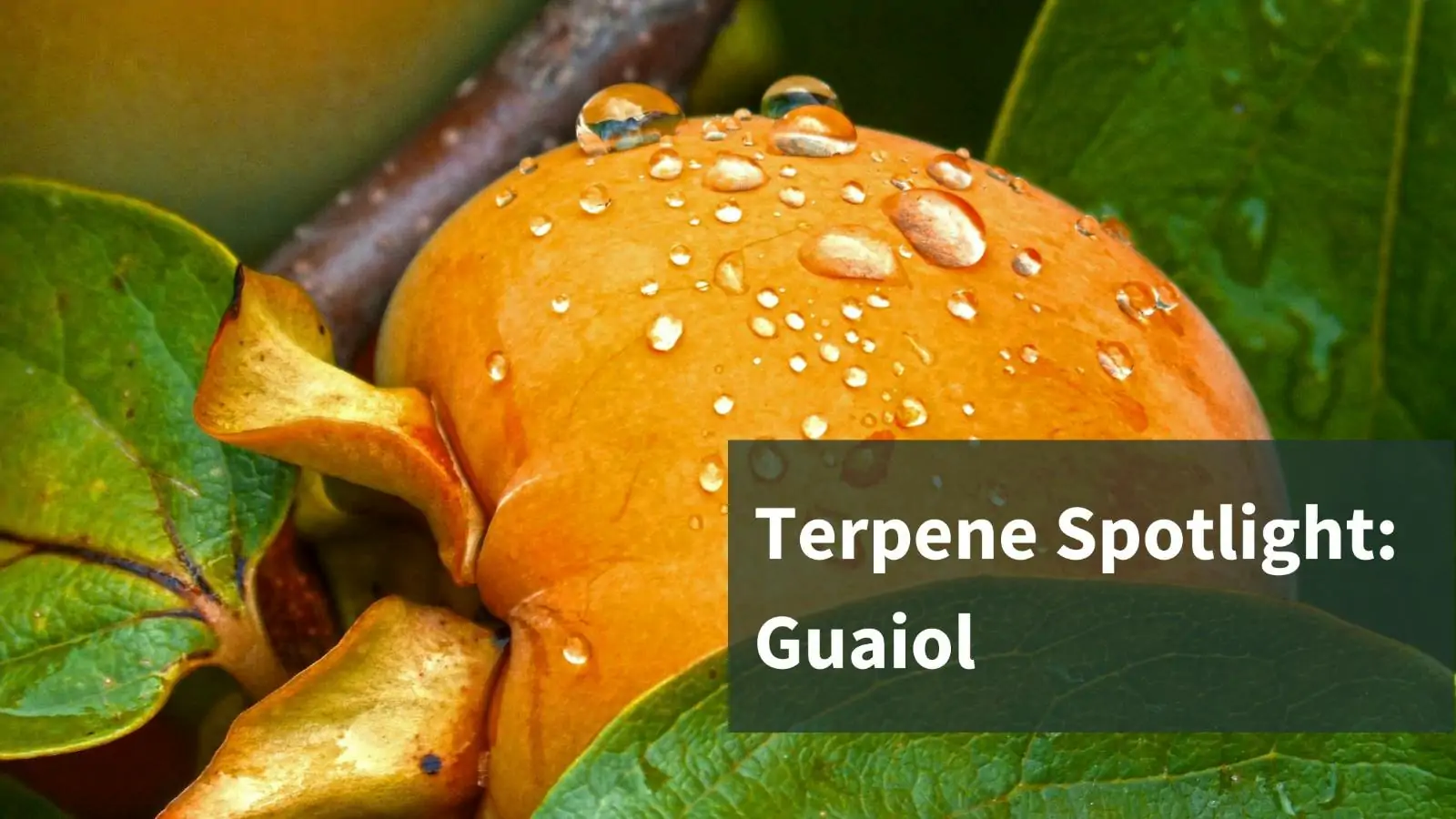No products in the cart.
Terpene Spotlight: Guaiol

Terpenes are garnering more attention recently, and for good reason. With the federal legalization of industrial hemp and the state-by-state legalization of THC cannabis, we’re learning that it’s not just the cannabinoids, THC and CBD, that we need to pay attention to. Terpenes, responsible for hemp’s pleasant aroma, are also responsible for modulating user experiences. The rest of this post will be dedicated to one such terpene called guaiol (pronounced g-why-ee-ol) and,
- Where you can find it in nature
- What we currently use it for
- And, guaiol’s potential benefits
What Are Terpenes?
Terpenes are a diverse group of organic compounds that contribute both to a plant’s aroma and its self-defense.¹ In flowering hemp plants terpenes deter deer and other herbivores by giving the flowers an overwhelmingly bitter taste.
The cosmetic and food industries love terpenes for their aroma, and by extension, their taste. If you open your medicine cabinet or fridge right now, you’ll likely find something containing terpenes. You’ve likely encountered terpenes in,
- Beer contains humulene— a terpene found in hops
- Household cleaners many of which contain pinene
- Many household herbs like basil contain ocimene
What Is Guaiol
Guaiol is a sesquiterpene alcohol (meaning it’s made of three isoprene units) found in various plants and some animals. Guaiol’s distinctive aroma lends itself to a handful of hemp strains as well as the guaiacum plant where it was first isolated from and subsequently named after.
Guaiacum has a long history of medicinal use, including helping with menstruation, soothing sore throats, and as a stimulant.
Fun fact: Scientists at CERN believe that sesquiterpenes, like guaiol, may play a major role in cloud formation!

What Is Guaiol Used For?
Aside from its years of medical use via the guaiacum plant, the terpene guaiol can also be found in nutmeg, cumin, lilacs, and tea trees.
Its unique scent, a mix of woodiness, pine, and rose, makes guaiol a highly sought-after terpene.
Guaiol’s Potential Benefits
As mentioned, guaiol has historically been used for its medicinal qualities. But as we’ve been able to isolate and study each terpene, academics are publishing studies about guaiol’s applications.
Anti-Inflammatory Properties
In a 2010 study, both guaiol and beta-caryophyllene exhibited statistically significant anti-inflammatory effects. As this study was performed in vitro, the results warrant further study.²
Antimicrobial & Anti-parasitic Properties
A few studies published in the last two decades found that guaiol is effective in combating parasites and harmful bacteria.³⁴ We should note that guaiol was just a part of the essential oils used in both studies and not isolated. Still, these results are interesting and could lead to new antimicrobial products using guaiol.
Anti-tumor Properties
Perhaps one of the most interesting studies about guaiol was published in 2016 in the Journal Oncotarget.⁵ Researchers isolated guaiol and found that the terpene inhibits tumor cell growth and proliferation. We will note that these results are from studies carried out in vitro, but even so, they are an exciting jumping-off point for further guaiol research.
Sunset Lake CBD Cultivars Featuring Guaiol
At Sunset Lake CBD, we pride ourselves on our approach to sungrown hemp. Not only do we think that producing hemp flowers outdoors is better for the environment, but some studies show that natural light increases terpene production in the flowers. This year we’ve got a handful of CBD hemp flower cultivars that prominently feature guaiol including,
- Suver Haze – 0.06% guaiol
- Super Sour Space Candy – 0.13%
- Sour Suver Haze – 0.15%
- Sour Lifter – 0.06%
- Hawaiian Haze – 0.06%
- Cherry Abacus – 0.08%
- Candy Kush – 0.06%
Sources:
- Divekar, Pratap Adinath et al. “Plant Secondary Metabolites as Defense Tools against Herbivores for Sustainable Crop Protection.” International journal of molecular sciences vol. 23,5 2690. 28 Feb. 2022, doi:10.3390/ijms23052690
- Apel, Miriam A et al. “Anti-inflammatory activity of essential oil from leaves of Myrciaria tenella and Calycorectes sellowianus.” Pharmaceutical biology vol. 48,4 (2010): 433-8. doi:10.3109/13880200903164386
- Andrade, Milene Aparecida et al. “Essential oils: in vitro activity against Leishmania amazonensis, cytotoxicity and chemical composition.” BMC complementary and alternative medicine vol. 16,1 444. 8 Nov. 2016, doi:10.1186/s12906-016-1401-9
- Choudhary, Muhammad Iqbal et al. “Microbial transformation of (-)-guaiol and antibacterial activity of its transformed products.” Journal of natural products vol. 70,5 (2007): 849-52. doi:10.1021/np068052a
- Yang, Qingyuan et al. “(-)-Guaiol regulates RAD51 stability via autophagy to induce cell apoptosis in non-small cell lung cancer.” Oncotarget vol. 7,38 (2016): 62585-62597. doi:10.18632/oncotarget.11540
